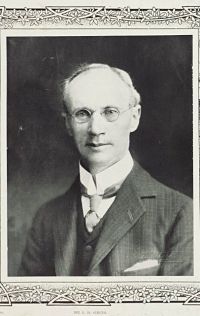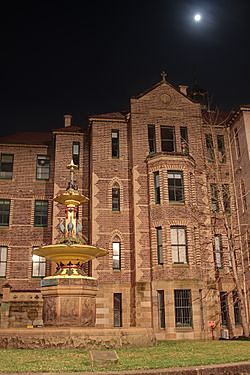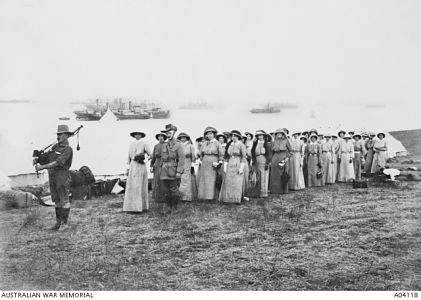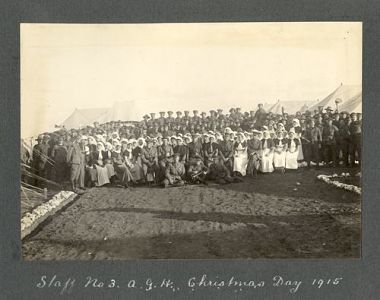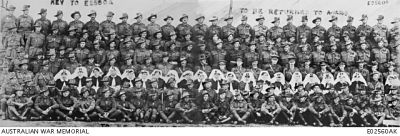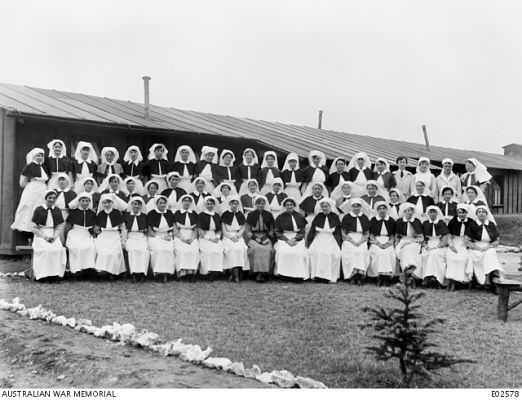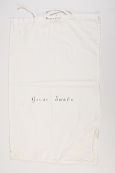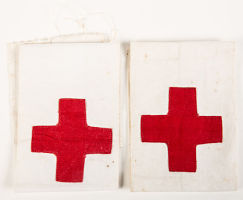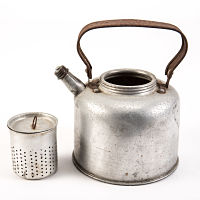WW1 Sister Elsie Stewart Greig RRC
Elsie was born on 10 April 1886 to Barbara Mary Stewart and James Dickson Greig in Charters Towers, northern Queensland, a town 134 kms inland from Townsville.
Her parents had married in Victoria in 1885. [1][2] Her mother Barbara Greig was born in 1860 to Janet Gillies and James Syme Stewart in Amherst, Victoria, Australia and died in 1942 aged 82. James was born in 1852 and died in 1925 aged 73. [3] Elsie had two sisters Barbara Sibyl Carr (1887 – 1970 and Roy (Roysie) Alma Nolan (1891 – 1969).
Born at Couper, Angus, Scotland, James Greig had joined the National Bank of Scotland, London branch. Three years later he went to Australia, and became one of the staff of the Bank of Australasia at Melbourne. Mr. Greig was employed at that bank at Beechworth, Victoria, when Ned Kelly and his gang of bushrangers were operating in the district. Afterwards he was manager of branches at Charter Towers, Maitland and Goulburn.[4]
During the last quarter of the 19th century when Elsie was born, Charters Towers boomed as gold was discovered and the rich deposits under the city were developed. During the boom years, between 1872 and 1899, Charters Towers hosted its own stock exchange. During this period, the population was approximately 30,000, making Charters Towers Queensland’s largest city outside of Brisbane.[5
The Charters Towers gold field produced over 200 tonnes of gold from 1871–1917. The gold is concentrated into veins and was Australia’s richest major field with an average grade of 34 grams per tonne. The grade was almost double that of Victorian mines and almost 75% higher than the grades of Western Australian (Kalgoorlie) gold fields of that time. By 1917 gold mining became uneconomic. During World War One labour was hard to find, and as the mines drove deeper, ventilation and water problems arose. This production decline was similar across Australian gold mines, with rising costs and a fixed gold price eroding profitability. The town entered a long period of relative stagnation and little further development has occurred since.
After three years at Goulburn in New South Wales, James Greig came to New Zealand in 1896 to manage the Bank of Australasia at Wanganui. On his departure from Australia, he was presented with a testimonial and a purse of sovereigns.[6]
James Greig became involved as a director of the Wanganui Public Library, Wanganui Museum, Wanganui Golf Club, Wanganui Orphanage and the Wanganui Bowling Club. In 1901 Mr Greig was reported as accompanying a bride Miss Fraser, principal of the Wanganui College, up the aisle who was “waited upon by three charming little maids — the Misses Greig, dressed in the very daintiest of white-muslin and lace frocks, with picture hats. They carried exquisite baskets of flowers, these latter, as well as handsome gold bracelets being the gifts of the bridegroom.” [7]
In 1905 James Greig was promoted to Auckland, and received a farewell gift of “a handsome smoker’s outfit and a travelling rug from the staff and sub-managers at Taihape and Marton. The presentation was made by Mr F. Dyer, who referred in eulogistic terms to Mr Grieg’s many good qualities, and though regretting his departure, heartily congratulated him on his promotion. Mr Greig feelingly replied, expressing the hope that the kindly relations that had existed in the past between the manager and the staff would over continue to exist.” [8]
In 1912 he retired from the Bank of Australasia. He received a cheque for £100, subscribed for by clients of the bank, and a framed address signed by the representatives of over thirty business firms. [9]
In 1908 Elsie was at Sydney Hospital, where she won the first year prize for a probationer nurse.[10] In 1913 Elsie’s address was Sydney Hospital, Macquarie St in the Castlereagh Street district, working as a nurse. [11]
Nursing training in Australia had begun at Sydney Hospital in 1868 when Florence Nightingale sent out Lucy Osburn and five other English sisters. The brick and sandstone Gothic Revival Nightingale Wing of 1869 off the central courtyard, with its colourful fountain, was built to house the female staff of the Hospital with the input of Florence Nightingale. [12]
When in Sydney Elsie enlisted for service in WW1 on 26 April 1915, her attestation giving the address of her father at the Bank of Australasia, Auckland. She was 29 ½ years, with a fair complexion, blue eyes and brown hair. She was 5ft 2 ½ inches and weighed 8st 8lbs. Her religion was given as Presbyterian. Elsie embarked overseas from Sydney on the RMS Mooltan on 15 May 1915. [13]
“The 3rd Australian General Hospital, commanded by Thomas Henry Fiaschi, left Circular Quay on the RMS Mooltan on 15 May 1915. The embarkation roll shows that the hospital’s staff were mainly drawn from Sydney. Reinforcements came from Victoria and South Australia. ‘The unit arrived in England on 27 June 1915, expecting to be posted to France. However, on 1 July, the commanding officer was informed that they would instead be deployed to Mudros, on the Greek island of Lemnos, where they would nurse the sick and injured troops fighting in the Gallipoli campaign. Lemnos was only 50 miles from the fighting, whereas the hospitals in Egypt were over 650 miles away, a journey of 1½ days.
3 A.G.H. was landed on Turk’s Head, West Mudros on 5 August 1915 … on a bare and roadless hillside—without tents or equipment, without water-supply other than the tank ships and with only one water-cart each, with no sanitary provision whatever and with little transport other than hand carriage—to prepare for the vast operations timed for the 6th. The sisters were landed a few days later, on the 7th and 8th. The Matron was Grace Wilson. The hospital’s laboratory equipment, together with the great bulk of its general hospital equipment, was not sent on by the War Office for three weeks. Its equipment had been put in another transport. [14]
When 3 A.G.H. first started admitting patients, the majority were wounded men from the August offensive, and it was these patients the hospital had been set up for, with operating theatres and surgeons on the staff. In later months, nearly all the patients were ill with either dysentery or paratyphoid. The staff of the hospital also fell ill, though the nurses suffered less, probably by practising better hygiene. in late November and December, the casualties changed again – troops were caught in freezing weather on the Peninsula without adequate clothing, and many were admitted to the hospitals on Lemnos suffering from severe frostbite.’
‘The last Australians were evacuated from Gallipoli on the night of 19/20 December 1915, and many spent Christmas on Lemnos while waiting for further orders. The whole evacuation of allied troops took three weeks. In spite of earlier predictions that up to half the remaining forces could be killed, the evacuations were so well planned that there were minimal casualties, which was a relief to the hospital staff who had been prepared for casualties. With the end of the Gallipoli campaign, the hospitals on Lemnos were disbanded. The nurses boarded the hospital ship Oxfordshire on 14 January, and sailed out of the harbour at Mudros on 17 January 1916, bound for Egypt.” [15]
No.3 Australian General Hospital was re-established at Abbassia in Egypt in early 1916 in an old harem, where it operated for approximately eight months. The staff then operated the Kitchener War Hospital at Brighton, England from October 1916 before moving to Abbeville, France, from May 1917.
No.3 Australian General Hospital arrived in France on 27.4.1917, with a nursing staff of 91, with Principal Matron G. M. Wilson Australian Army Nursing Services (A.A.N.S.) as Matron. They were temporarily accommodated in the Abbeville and Treport areas until the unit, which was opening on a new site at Abbeville was ready to receive them. By the first week in June the Sisters’ quarters were completed, and the whole staff rejoined.
During the last week in March 1918, the military situation was considered sufficiently critical to cause all hospitals in the Abbeville area to be reduced to a number of nursing staff sufficient for Casualty Clearing Station duties. On the 1st, 2nd and 3rd of April, 60 A.A.N.S. Sisters were sent in groups of 10 or 20 by passenger or Ambulance Train to Boulogne, so that by April 4th, the staff was reduced to 26 trained nurses, and 2 Red Cross workers. Elsie was sent to No. 3 Australian Casualty Clearing Station close to the front line in April 1917. On 27 May, she was back at Abbeville. Ambulance trains were obliged to continue unloading at Abbeville and the convoys admitted to the hospitals were very heavy ones, so that it was very shortly found necessary to increase the staff, and as the military situation improved, it was brought back to its full strength.
For two years from May 1917 to June 1919, Elsie was with No. 3 AGH near the front line in France and Flanders, apart from leave periods in England, Paris and the South of France. No.3 Australian General Hospital closed for admissions on 16.4.1919, and was instructed to be ready for withdrawal from France by May 20th. The Nursing Staff returned to England in parties of 10, beginning on 17.5.19, and the last party with Principal Matron Grace Wilson proceeded on 23.5.19. Fourteen members of No.3 who were due or overdue leave were given leave warrants to their destinations before proceeding to the United Kingdom.
Elsie was twice Mentioned in Despatches – the 1917 citation read: Sister Greig, Elsie Stewart. This Sister has been in charge of the Acute Surgical Ward and also one room in the Operating Theatre. She has shown throughout, great devotion to duty, also skill and tact in her work and has always been ready and willing to undertake any extra work and strain which has come along. She has always set a constantly high example of conduct and of ready cheerfulness both in her work and in the daily life of the unit. [16]
Elsie was again Mentioned in Despatches in 1919 for conspicuous and gallant services in the field during the period February to September 26th 1917. (57/18 Mo. 170/8) and awarded the Royal Red Cross 2nd Class dated 1.1.19 (London Gazette 31092) and then 1st Class, according to Australian records.[17]
Her father received a letter from the Australian Imperial Force stating: HIS MAJESTY THE KING has been graciously pleased to award the Royal Red Cross to the undermentioned lady of the Nursing Services in recognition of her valuable services with the armies in France and Flanders. [18]
The New Zealand Herald reported: News has been received that Miss Elsie Greig, eldest daughter of Mr. and Mrs. J. D Greig, has been, awarded the honour of the Royal Red Gross. Sister Greig is one of the Main Body nurses, leaving , with the Third Australian Hospital unit, She has seen service at Gallipoli, Cairo, France and England, and has been mentioned in dispatches. [19]
Elsie was awarded the 1914-1918 Star medal; the British War Medal and the Victory Medal. Because she was mentioned in despatches (twice), she would also have received the oak leaf emblem clasp.[20]
Elsie was granted leave from 15.7. 19 to 15.11.19 with pay & subs(istence expenses) to complete a Midwifery course (I.D.2) at Rotunda Hospital in Dublin. She was paid 12/- per day allowance with 6/- per day subsistence expenses. [21]
In March 1920 Elsie was with No. 4 Australian General Hospital. After developing varicose veins and having ongoing episodes of appendicitis when she was in France in 1918, she was discharged as unfit for military service. Elsie returned to Australia in 1919 on the ‘Runic’. In 1921 Elsie was nursing at the Children’s Hospital in Melbourne. The following addresses were in the electoral rolls: Victoria 1921 and 1922 Melbourne, Cardigan- Children’s Hospital Trained Nurse Victoria 1924 Melbourne, Gipps 495 Victoria Parade – Nurse Victoria 1925 Melbourne, Gipps ditto [22]
By 1928 she had returned to New Zealand and lived in Remuera where she cared for her mother. During WW2 she did some work with the Emergency Precautions Service in Remuera during WW2. The New Zealand Electoral Roll showed the following residential addresses, bearing in mind that street numbering changed after WW2 to accommodate the subdivision of large sections
– New Zealand Electoral Roll 1928 – 4 Victoria Avenue
– New Zealand Electoral Roll 1935 – 4 Victoria Avenue
– New Zealand Electoral Roll 1938 – 8 Victoria Avenue
– New Zealand Electoral Roll 1946 – 8 Victoria Avenue
– New Zealand Electoral Roll 1949 – 8 Victoria Avenue
-New Zealand Electoral Roll 1954 – 8 Victoria Avenue
– New Zealand Electoral Roll 1957 – 8 Victoria Avenue
– New Zealand Electoral Roll 1963 – 10 Victoria Avenue
There are three items belonging to Elsie in the collections of the Auckland War Memorial Museum:
• First aid bag marked “Remuera / Gauze Swabs”; probably part of WW2 EPS kit, which belonged to Miss Elsie Greig. A white cotton bag, woven cloth tag (red on white) sewn to inside top: “HORROCKSES REGD CLOTH” marked in ink on side: “gauze swabs”; marked along outside top edge: “Remuera”. [24]• Nursing armbands. DESCRIPTION: pair of nursing armbands, possibly belonged to Nurse Barbara S Greig, QAIMNSR, WW1. Otherwise belonged to her sister Elsie Greig who served with the Australian Nursing Service, WW1 and worked with the Emergency Precautions Service (Remuera) during WW2 white linen with applique red-cross. [25]
• Spirit kettle which is on display: Aluminium kettle with strainer issued to Australian nursing staff as part of an emergency supply kit, during WW1; belonged to donor’s aunt, Elsie Greig. The display comprises four parts: kettle, strainer, lid and cap (spout). [26]
Elsie died on the 20 March 1966 aged 79. [27]. Her ashes are buried at Purewa Cemetery, Block A Flow 30 Plot 60. [28]
